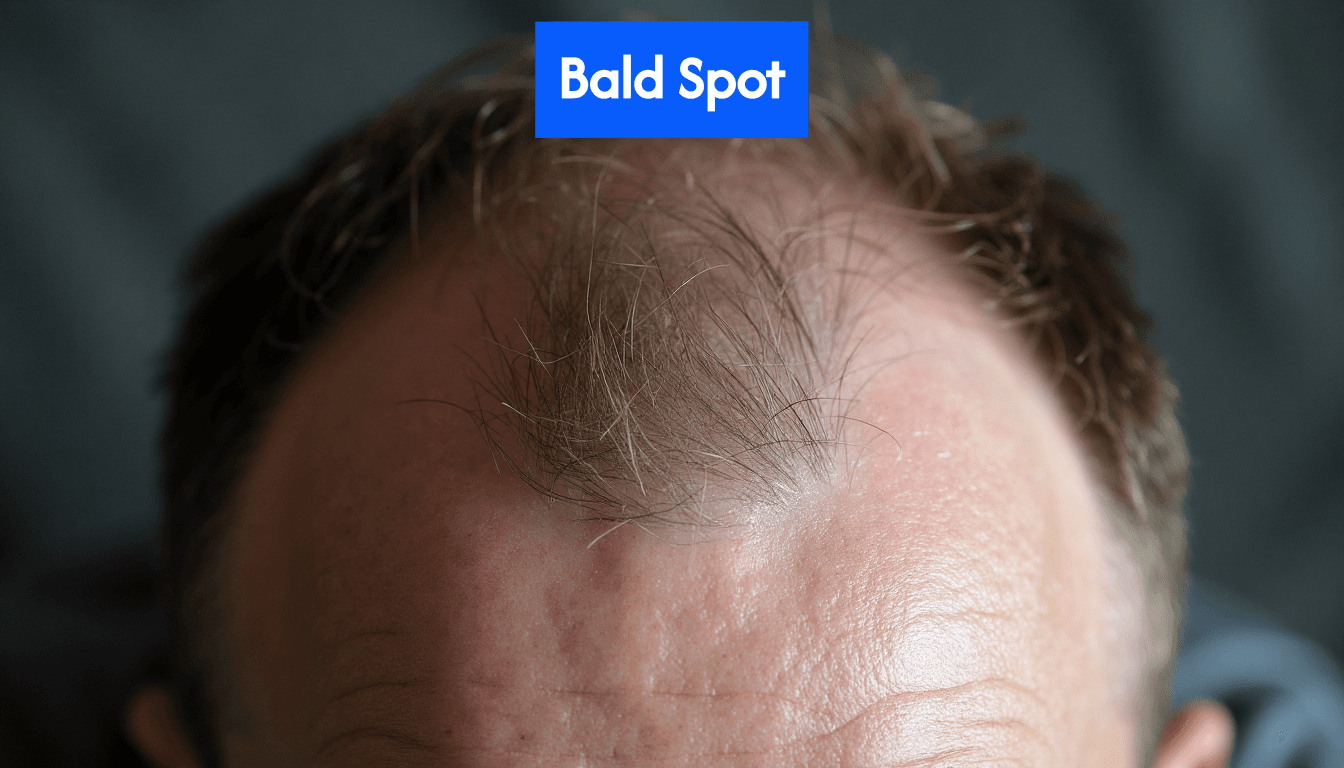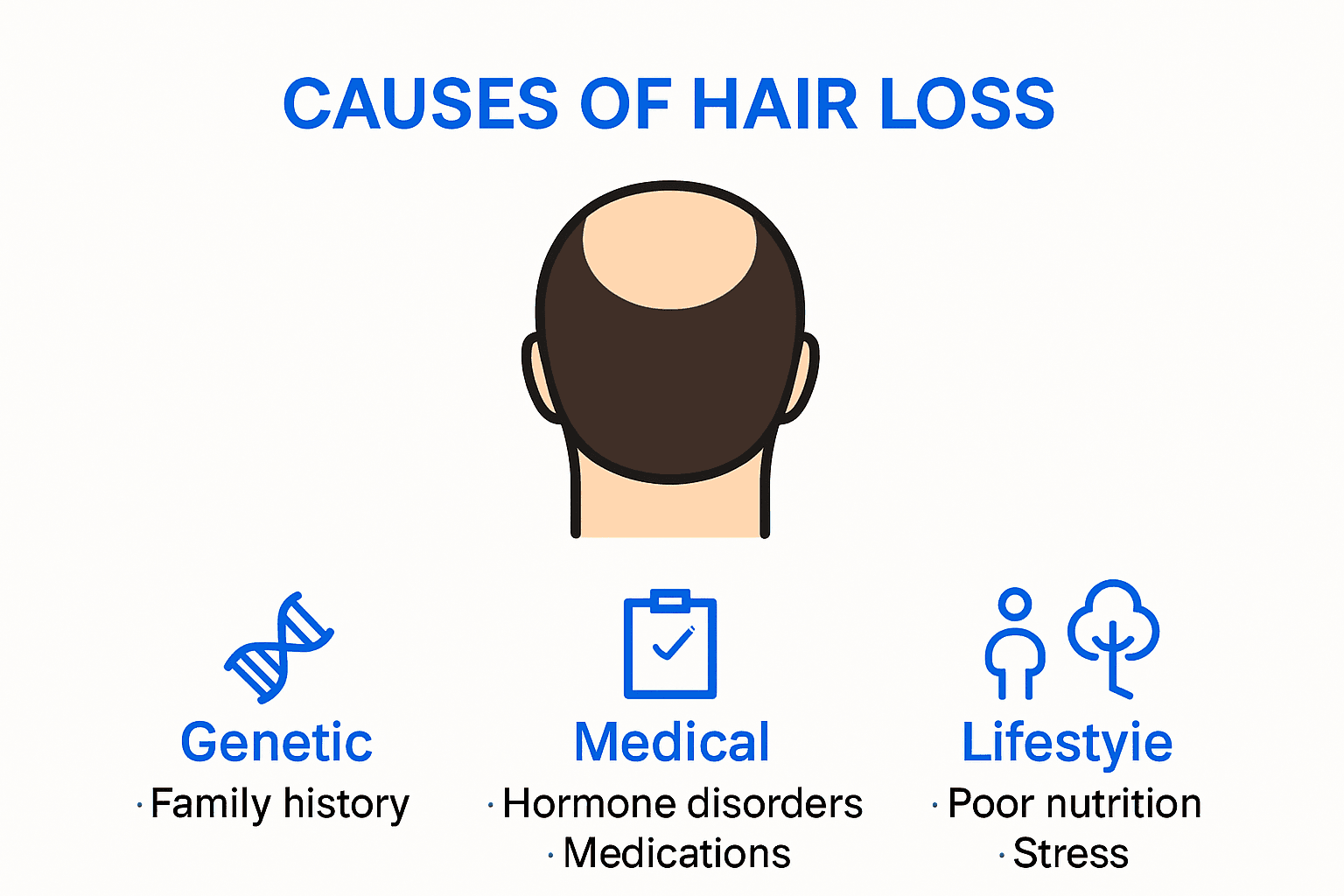Blog
Learning Materials
Bald Spot on Crown: Spotting, Causes, and Treatment
Updated: June 3, 2025

A bald spot on your crown might seem like a small cosmetic issue, but the reality is much bigger than you think. Nearly 30 to 50 percent of men will experience crown hair loss by age 50, and that number starts creeping higher as early as your thirties. People usually assume stress or shampooing habits are to blame. Not so fast. Genetics and subtle hormonal shifts play a much larger role, often catching you totally off guard. Here is where the real surprises about hair loss on the crown start to reveal themselves.
Table of Contents
- What A Bald Spot On The Crown Looks Like
- Why You Might Have A Bald Spot
- Effective Ways To Treat Crown Hair Loss
- When To Speak To A Hair Doctor
Quick Summary
| Takeaway | Explanation |
|---|---|
| Identifying Bald Spots | A bald spot on the crown appears as a distinct circular or oval area with reduced hair density, often starting with subtle thinning. Recognizing early signs can prompt timely intervention. |
| Causes of Hair Loss | Crown hair loss can result from genetic factors such as androgenetic alopecia, medical conditions, hormonal changes, and lifestyle choices like poor nutrition and stress. Understanding these causes is essential for effective management. |
| Proof of Efficacy in Treatments | Medical treatments like minoxidil and finasteride can help slow hair loss and promote regrowth, while advanced solutions like PRP therapy and surgical options provide alternative routes for severe cases. |
| When to Seek Professional Help | Consulting a hair doctor is advisable when experiencing sudden hair loss, noticeable bald spots, or emotional distress related to hair changes. Early intervention can enhance treatment success and preserve hair health. |
What a Bald Spot on the Crown Looks Like
Identifying a bald spot on the crown requires understanding its unique characteristics and progression. Unlike other types of hair loss, a crown bald spot presents specific visual markers that can help individuals recognize early signs of thinning or complete hair loss in this region.
Identifying the Physical Characteristics
A bald spot on the crown typically manifests as a circular or oval-shaped area of visible scalp where hair density dramatically reduces or disappears completely. This region is located at the top back part of the head, often referred to as the vertex or crown area. The spot usually appears as a distinct patch that contrasts sharply with surrounding hair, creating a noticeable difference in hair coverage.
Initial stages of crown balding might present subtly. You may first notice hair thinning rather than a complete absence of hair. The area might look lighter or less dense, with individual hair strands becoming progressively finer and more sparse. Dermatology experts suggest that this gradual thinning can be an early warning sign of more significant hair loss to come.
Progression And Visual Indicators
The visual progression of a crown bald spot follows a predictable pattern. What starts as slight thinning can evolve into a more pronounced area of hair loss. Men typically experience this type of balding more frequently, with the crown being one of the first areas to show significant hair reduction. The bald spot might initially be small a quarter-sized area that slowly expands outward.
Key visual indicators include:
- A clearly visible scalp patch at the crown
- Reduced hair density in a circular or oval shape
- Thinner hair strands around the balding area
- Gradual widening of the bald spot over time
Interestingly, some individuals might have a natural hair whorl at the crown which can sometimes be mistaken for early balding. However, a true bald spot will show consistent thinning and lack of hair growth, unlike a normal hair whorl which maintains some hair coverage.
Understanding Size And Spread
The size of a bald spot on the crown can vary significantly between individuals. Some might experience a small, quarter-sized area of hair loss, while others could see a larger region covering several inches. Trichology research indicates that genetic factors play a crucial role in determining the extent and pattern of crown hair loss.
Men are more likely to develop a prominent bald spot at the crown, with patterns often following familial genetic traits. Women can also experience crown hair loss, though it typically presents differently less dramatically than male pattern baldness. The spread of the bald spot can be gradual or relatively rapid, depending on underlying health conditions, genetic predisposition, and hormonal changes.
Recognizing these visual characteristics early can help individuals seek appropriate treatment and management strategies for crown hair loss. Whether through medical interventions, lifestyle changes, or cosmetic solutions, understanding what a bald spot looks like is the first step in addressing this common hair health concern.
Why You Might Have a Bald Spot
Understanding the underlying causes of a bald spot on the crown requires exploring multiple factors that contribute to hair loss. While genetics play a significant role, several other elements can trigger or accelerate hair thinning and baldness in this specific area.
Genetic Predisposition and Hormonal Influences
Androgenetic alopecia, commonly known as male or female pattern baldness, represents the most prevalent cause of crown hair loss. Genetic research indicates that approximately 30-50% of men will experience this type of hair loss by age 50. The primary culprit is dihydrotestosterone (DHT), a testosterone byproduct that causes hair follicles to shrink progressively.
Hormonal changes significantly impact hair growth patterns. In men, DHT binds to hair follicle receptors, causing them to miniaturize and eventually stop producing hair. Women can experience similar hormonal-driven hair loss during significant life stages like pregnancy, menopause, or when experiencing thyroid disorders.
Medical Conditions And Health Factors
Several medical conditions can contribute to crown hair loss beyond genetic predisposition. Dermatological studies highlight multiple health-related triggers:
- Autoimmune disorders like alopecia areata
- Thyroid dysfunction
- Scalp infections
- Nutritional deficiencies
- Stress-related hair loss
- Certain medications
Stress emerges as a significant contributor to hair loss. Telogen effluvium, a condition where stress pushes hair follicles into a resting phase, can cause sudden and noticeable thinning at the crown. Chronic stress disrupts normal hair growth cycles, potentially accelerating baldness.
Lifestyle And Environmental Factors
Beyond medical conditions, lifestyle choices dramatically influence hair health. Nutritional experts emphasize that diet, exercise, and environmental exposure play crucial roles in maintaining healthy hair growth.
Key lifestyle factors include:
- Poor nutrition lacking essential proteins and minerals
- Excessive alcohol consumption
- Smoking
- Lack of sleep
- High-stress occupations
- Exposure to environmental pollutants
- Harsh hair treatments and chemical processes
Nutritional deficiencies in iron, protein, and vitamins B12 and D can significantly impact hair growth. Individuals with restricted diets or those experiencing rapid weight loss might notice increased hair thinning at the crown.
Interestingly, research shows that 25% of men begin experiencing hair loss by age 30, with the crown being a primary area of concern. While some factors are uncontrollable, understanding these potential causes empowers individuals to take proactive steps in managing and potentially mitigating hair loss.

Effective Ways To Treat Crown Hair Loss
 Treating crown hair loss requires a multifaceted approach that combines medical interventions, lifestyle modifications, and advanced therapeutic techniques. Understanding the range of available treatments can help individuals make informed decisions about managing their hair loss effectively.
Treating crown hair loss requires a multifaceted approach that combines medical interventions, lifestyle modifications, and advanced therapeutic techniques. Understanding the range of available treatments can help individuals make informed decisions about managing their hair loss effectively.
Medical Treatments And Pharmaceutical Solutions
Topical and oral medications represent the first line of defense in treating crown hair loss. Hair restoration specialists recommend two primary pharmaceutical interventions:
-
Minoxidil: A topical solution that stimulates hair regrowth by increasing blood flow to hair follicles. Available over-the-counter, it works by extending the growth phase of hair follicles and can be particularly effective for early-stage crown thinning.
-
Finasteride: An oral medication that blocks DHT production, the hormone responsible for male pattern baldness. Clinical studies show it can slow hair loss and potentially reverse thinning in the crown area.
These medications work best when started early and used consistently. However, they require ongoing use to maintain results and may have potential side effects that should be discussed with a healthcare professional.
Advanced Therapeutic Interventions
For individuals seeking more comprehensive solutions, several advanced treatments offer promising results. Dermatological research highlights innovative approaches:
Platelet-Rich Plasma (PRP) Therapy: A cutting-edge treatment that uses the patient's own blood platelets to stimulate hair growth. The procedure involves:
- Extracting a small amount of the patient's blood
- Concentrating the platelets
- Injecting the growth factor-rich plasma into the crown area
PRP has shown particular promise for early to moderate crown thinning, with many patients experiencing improved hair density and thickness.
Surgical And Permanent Solutions
For those with more advanced hair loss, surgical interventions provide a more permanent solution. Hair transplant experts recommend two primary surgical approaches:
Follicular Unit Extraction (FUE): A minimally invasive surgical technique that:
- Extracts individual hair follicles from donor areas
- Precisely transplants them to the thinning crown region
- Maintains the natural swirl pattern of crown hair
This method offers a permanent solution for those with significant crown baldness, with results that look natural and blend seamlessly with existing hair.
Additional considerations for treatment success include:
- Consulting with a trichologist or dermatology specialist
- Understanding individual hair loss patterns
- Maintaining a healthy lifestyle
- Managing stress
- Ensuring proper nutrition
Treatment effectiveness varies between individuals. What works for one person may not yield the same results for another. Patience and a comprehensive approach combining medical treatments, lifestyle modifications, and potentially surgical interventions offer the best chance of managing crown hair loss successfully.
Consult with a hair restoration professional to develop a personalized treatment plan tailored to your specific hair loss pattern and overall health conditions.
When to Speak to a Hair Doctor
Recognizing the right moment to consult a hair doctor can be crucial in managing and potentially reversing hair loss. While some hair thinning is normal, certain signs indicate the need for professional medical intervention to address underlying causes and prevent further progression.
Early Warning Signs Requiring Professional Attention
Medical experts recommend seeking professional help when hair loss becomes persistent or emotionally distressing. Critical indicators that warrant a consultation include:
- Sudden or rapid hair loss creating visible thinning
- Noticeable bald spots developing on the crown or other areas
- Hair falling out in clumps during brushing or washing
- Significant changes in hair texture or density
- Scalp irritation or unusual skin conditions accompanying hair loss
- Family history of early or aggressive hair loss
Unexplained hair loss can signal underlying health conditions beyond typical genetic patterns. Conditions like thyroid disorders, autoimmune diseases, and nutritional deficiencies can manifest through hair loss, making professional evaluation essential.
Comprehensive Diagnostic Approaches
Trichology specialists typically employ a comprehensive diagnostic approach when evaluating hair loss. The initial consultation usually involves:
- Detailed medical history review
- Scalp and hair follicle examination
- Potential blood tests to check hormonal levels
- Scalp biopsy if unusual patterns are detected
- Evaluation of genetic predisposition
These diagnostic steps help determine whether your hair loss stems from genetic factors, medical conditions, nutritional issues, or a combination of influences. Understanding the root cause allows for targeted and effective treatment strategies.
Psychological And Emotional Considerations
Beyond physical assessment, mental health professionals recognize that hair loss can significantly impact psychological well-being. Consulting a hair doctor becomes crucial when hair loss begins to affect:
- Self-confidence and personal image
- Social interactions and professional performance
- Mental health and emotional stability
- Quality of life and personal relationships
Many individuals experience anxiety, depression, and social withdrawal due to hair loss. A specialized hair doctor can provide not just medical treatment but also psychological support and counseling.
Additional reasons to seek professional help include:
- Persistent concerns about hair loss progression
- Desire for personalized treatment options
- Need for expert guidance on prevention strategies
- Understanding genetic predispositions
- Exploring both medical and cosmetic solutions
Remember, early intervention offers the best chance of managing hair loss effectively. While not all hair loss can be stopped or reversed, professional guidance can help slow progression, improve hair health, and provide comprehensive support through the process.
Do not hesitate to schedule a consultation if you are experiencing consistent or troubling hair loss. A professional assessment can provide clarity, peace of mind, and a path forward.
Frequently Asked Questions
What does a bald spot on the crown look like?
A bald spot on the crown typically appears as a circular or oval-shaped area where hair density is significantly reduced or completely absent. It often contrasts sharply with surrounding hair, making it noticeable.
What causes hair loss on the crown area?
Crown hair loss can be caused by genetic factors like androgenetic alopecia, hormonal changes, medical conditions, lifestyle choices such as poor nutrition and stress, and certain environmental factors.
How can I treat a bald spot on my crown?
Treatment options for crown hair loss include medical treatments like minoxidil and finasteride, advanced therapies such as PRP (Platelet-Rich Plasma) therapy, and surgical options like follicular unit extraction (FUE).
When should I see a doctor about my hair loss?
You should consider consulting a hair doctor if you experience sudden or rapid hair loss, notable bald spots, changes in hair texture, or if hair loss affects your self-esteem or emotional well-being.
Discover Personalized Solutions for Crown Bald Spots!
If you’re one of the many experiencing crown hair loss, you know how emotionally challenging it can be. The article on spotting, causes, and treatments for bald spots on the crown highlights key issues like genetic predisposition and lifestyle factors that contribute to this common concern. Don't let these challenges overwhelm you when there's a personalized approach available!
!
Take control of your hair health today! With MyHair.ai, we offer a unique, AI-driven solution that analyzes your hair health through personalized scans. Get tailored insights that focus on your specific hair loss patterns, empowering you to make informed decisions about products and treatments that work for YOU. Don't wait for your bald spot to expand— act now and join countless others who have transformed their hair journey with the help of MyHair.ai. Visit us at https://myhair.ai and take your first step towards revitalizing your hair growth!